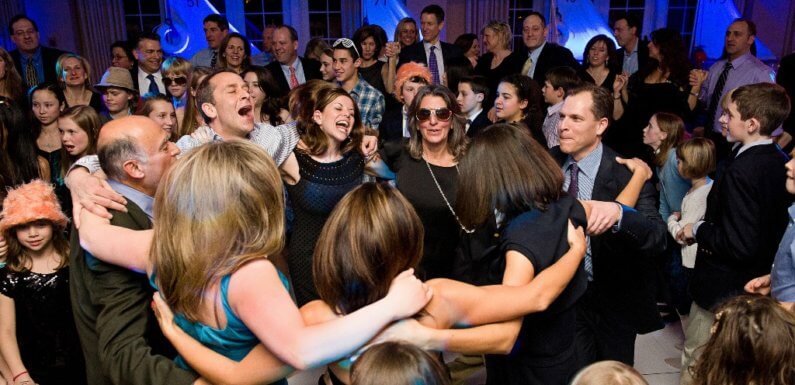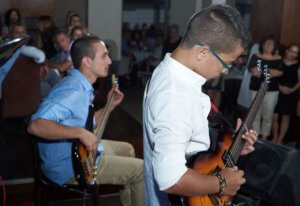
If you’re not Jewish and this is your first bar mitzvah, you’re likely brimming with questions. Even if you’re familiar with this religious milestone, ceremonies and parties have changed in the last 35 years. So, you’ve come to the right place for current information.
In this article, you’ll learn the protocols for the synagogue service, celebratory gatherings, and gift-giving. By following this guide, you can approach the events with confidence and ease. By the way, the tips below apply to a bat mitzvah, too!
Temple Etiquette
Event Significance
A bar mitzvah ceremony is a pivotal occasion, marking a Jewish boy’s maturation at age 13. The event signifies a young man’s commitment to observing Judaic rites and commandments. To prepare for the momentous day, the boy takes a 13-week class. Additionally, many synagogues require students to complete a community service project.
Similarly, a bat mitzvah announces a girl’s adulthood at age 12 and her pledge to practice Judaism. While the ceremony is slightly different for a young woman, guest participation is the same as for a bar mitzvah.
Gift-Giving
Traditionally, guests bestow the celebrant with a gift, brought to the party. The reception will likely have a table to receive presents. Your gift can be money, a tangible item, or both. If you choose to offer cash or a check, Judaic custom calls for money in multiples of 18, representing life or “chai” in Jewish numerology.
Ideally, an object should have spiritual meaning, paying tribute to Jewish heritage. For a boy, examples are a kippah, bar mitzvah tallit, Jewish prayer book, or Torah pointer. A girl will value Shabbat candlesticks, a Tree of Life necklace, or a tzedakah box, an ornate vessel to collect money for charity.
Suitable for both genders is a Star of David necklace pendant. The six-pointed star, made of two intersecting triangles, represents the union between God, Israel, and Torah. Another treasured gift option is a mezuzah. This is a small, rectangular box, containing a parchment on which Torah passages on handwritten in Hebrew. The mezuzah is affixed to the right entryway of a Jewish home or a resident’s room.
Religious Garb
Along with wearing suitable clothing, you’ll want to don worship garments. As you enter the temple lobby, an usher may offer you a prayer shawl or “tallit.” This lustrous, striped vestment is worn by Jewish men, along with women at liberal synagogues. Edging the cloth is braided fringe, symbolizing Judaic commandments. If you’re not Jewish, you can decline a tallit without being offensive.
However, to be respectful, a man should put on a small cap called a “kippah” or “yarmulke.” Although the tallit reflects Jewish allegiance, wearing a kippah honors God and the synagogue. In some congregations, women also cover their heads with a kippah or lace kerchief.
Most temples keep a basket of kippahs in their lobbies. Frequently, parents provide custom-made kippahs, featuring the celebrant’s name and ceremony date. These are intended for guests to take home, as mementos.
Worship Format
Frequently, a bar mitzvah ceremony occurs on the Sabbath or “Shabbat.” the exact time frame varies between Friday night and Saturday morning or afternoon. A rabbi conducts the service, lasting two hours, on average.
Usually, it starts with the boy reading a passage from the “Torah,” a foundational Hebrew scripture. Subsequently, the honoree may read prayers in English. Beyond this, worship customs vary by Jewish denomination, whether Reform, Orthodox, or Conservative.
In some traditions, the boy presents his interpretation of scripture from the Torah or “haftarah,” a compilation of prophetic books. Alternatively, the celebrant might describe their service project or share the origin of their Hebrew name. Additionally, the honoree’s family and friends may take part in the ceremony.
Your Participation
Arrival Time
Since bar mitzvah rites follow worship, guests often arrive late. However, this habit disrupts the focus of those already participating. Therefore, please adhere to the time shown on your invitation. Your punctuality will be appreciated by the parents, celebrant, and worship leaders.
Seating
If the congregation is Reform, sit wherever you like. In traditional communities, men and women sit in separate sections. Still, there may be an area designated for bar mitzvah guests. If not, take any seat on the side corresponding to your gender.
Joining Worship
In most Reform temples, chosen friends may stand with the honoree and family at the raised platform or “bimah.” at Conservative and Orthodox synagogues, special privileges may be limited for non-Jews.
However, regardless of the denomination, you should stand and sit when the congregants do. They’ll also perform other rites, but you’re not required to join. Most communities have prayer books with English translations, by which you can follow the Hebrew recitations.
If you fumble some gestures or miss them altogether, that’s fine. Even though you might feel embarrassed, no one will track your blunders. Rather, congregants will welcome your efforts. This is because joining worship shows respect, rather than professing Judaism.

Synagogue Rules
To preserve the sanctity of the occasion and worship space, here a few rules to honor. Beepers and cellphones should either be off or in vibration mode. Taking photographs isn’t permitted. However, your host likely hired a photographer or videographer for the ceremony. If you’d like a video or photo, call the parents and ask if you can place an order.
Although you may see congregants chatting during worship, it’s disrespectful. If you must communicate with someone, speak softly. Also, refrain from writing. Smoking is forbidden anywhere on synagogue property, including the building and grounds.
Candy Shower
On a lighter note, some services include tossing candy at the celebrant upon entering and leaving the bimah. This gesture symbolizes wishing them “sweet adulthood.” After further prayers, children are welcome to take a piece of candy from the bimah.
However, not all families observe this tradition. If you’d like to buy sweets for the occasion, call the parents first, asking whether a candy shower will be held. If so, make sure the candy you buy is kosher and individually wrapped.
Another fun custom is hoisting the honoree on a chair and dancing them around the bimah. Meanwhile, attendees form a circle around the boy or girl, clapping and dancing. If this doesn’t occur in the synagogue, it will likely happen at the party.
Being held aloft symbolizes two things for the honoree. One is being closer to God. Secondly, the celebrant is enveloped by community support.
Post-Ceremony Gatherings
Luncheon
Usually, a Shabbat morning service is followed by a “kiddush,” a sanctification rite, including a light meal. Upon entering the kiddush, you may be greeted with “Shabbat Shalom,” translated “Sabbath of Peace.” Your reply can be “Shabbat Shalom” or “Shalom.” When congratulating the parents and honoree, say “Mazel tov,” meaning “Best of Luck.”
Before the meal starts, a blessing is recited over a chalice of wine, symbolizing joy. If seating is assigned, look for your place card on a table, specifying where to sit.
Dress Codes
For both coming-of-age ceremonies, you need formal attire. First, check to see if your invitation specifies a dress code. If not, consider calling the synagogue for what’s appropriate. Alternatively, a safe bet for a woman is a modest dress or blouse and skirt. Note that bare shoulders are taboo and must be covered by a cardigan or shawl. Men should wear a suit, button-down shirt, and simple tie.
Are you married with one or more kids? If so, and your invitation is addressed to you and your spouse, bringing children isn’t appropriate. However, if the card is addressed to your family, the whole clan is welcome to attend.
Like the invited adults, kids should dress conservatively. For a girl, this means a respectable dress that will summon an approving smile from elders. A suit is ideal for a boy. However, also acceptable is a button-down shirt, paired with a tie and dress pants. A blazer is a nice touch. For shoes, a casual style is fine, but not sneakers.
Hopefully, you don’t need to buy new outfits, but if so, don’t strain your budget. Department stores like Walmart and Target sell quality clothing at reasonable prices. Here are additional tips for navigating the ceremony and party with young children.
Party
The reception site varies by family, such as a restaurant, ballroom, or country club. Wherever the party is held, it will likely feature an elaborate meal and dancing. If you’re Jewish and only eat kosher food, ask if there’s a kosher supervisor and whether your diet can be accommodated. Formal party attire would be the dress code. Similarly to going to a Quinceañera or wedding.
If the ceremony isn’t on Shabbat, the party will include music. In that case, count on seeing the “hora,” a spirited circle dance with guests holding hands.
Another cherished tradition is the candle-lighting ceremony. With this, the celebrant honors certain friends and family by lighting a candle for each.
Rich Traditions
According to Judaic custom, a bar/bat mitzvah denotes that the celebrant is morally and spiritually mature. During the ceremony, the honoree commits to observing Jewish commandments that prioritize family, community, and God. Simultaneously, the hosting synagogue welcomes the young adult into their community.
Both the ceremony and parties are steeped in symbolism. However, celebrations vary by Jewish denomination and family preference. Still, you can trust the advice presented here, as a general guide.
Having read this article, you’re familiar with what occurs at a synagogue, kiddush, and reception. You know what gifts are greatly valued. So, mark your calendar and respond to your invitation, if you haven’t already.
Enjoy the celebration You’ll be immensely blessed!
Kara Masterson is a freelance writer from Utah. She enjoys Tennis and spending time with her family.

